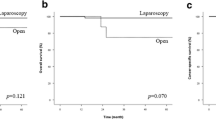Abstract
Background
In colon cancer, the number of harvested lymph nodes is critical for pathological staging. It has been proposed that the more central the mesenteric vascular ligation, the greater the nodal yield. The aim of the current study was to determine the association of radiological and pathological ileocolic pedicle length on nodal harvest following right hemicolectomy for caecal cancer.
Methods
A series of 50 patients undergoing right hemicolectomy for adenocarcinoma underwent specimen evaluation. Preoperative computed tomography images were reconstructed and analysed to determine the direct (vessel origin to caecum) ileocolic pedicle length.
Results
The median pathological distance from the tumour to the high vascular tie was 80 mm, and median nodal yield was 16.5 nodes. Radiological pedicle length did not correlate with the pathological distance from the tumour to the high vascular tie or nodal yield; however, the pathological pedicle length did correlate with the total nodal yield (r 2: 0.343, p = 0.015). The median pathologically determined length of colon resected (r 2: 0.153, p = 0.289), ileum resected (r 2: 0.087, p = 0.568) and total specimen length resected (r 2: 0.182, p = 0.205) did not correlate with the total nodal yield. An ileal specimen length ≤25 mm [hazard ratio (HR) 14.8, 95 % confidence interval (CI) 1.1–194.5, p = 0.040] and a well-differentiated tumour (HR 10.5, 95 % CI 1.1–95.9, p = 0.037) increased the likelihood of retrieving <12 lymph nodes.
Conclusions
Based on these data, pathologic pedicle length is a determining factor in lymph node retrieval. Preoperative radiological calculation of pedicle length does not help predict the number of lymph nodes retrieved.

Similar content being viewed by others
References
Heald RJ, Husband EM, Ryall RD (1982) The mesorectum in rectal cancer surgery—The clue to pelvic recurrence? Br J Surg 69:613–616
Heald RJ, Moran BJ, Ryall RD, Sexton R, MacFarlane JK (1998) Rectal cancer: the Basingstoke experience of total mesorectal excision, 1978–1997. Arch Surg 133:894–899
Birgisson H, Talback M, Gunnarsson U, Pahlman L, Glimelius B (2005) Improved survival in cancer of the colon and rectum in Sweden. Eur J Surg Oncol 31:845–853
Iversen LH, Norgaard M, Jepsen P, Northern Danish Cancer Quality Assessment Group et al (2007) Trends in colorectal cancer survival in northern Denmark: 1985–2004. Colorectal Dis 9:210–217
Bokey EL, Chapuis PH, Dent OF, Mander BJ, Bissett IP, Newland RC (2003) Surgical technique and survival in patients having a curative resection for colon cancer. Dis Colon Rectum 46:860–866
West NP, Morris EJ, Rotimi O, Cairns A, Finan PJ, Quirke P (2008) Pathology grading of colon cancer surgical resection and its association with survival: a retrospective observational study. Lancet Oncol 9:857–865
Hohenberger W, Weber K, Matzel K, Papadopoulos T, Merkel S (2009) Standardized surgery for colonic cancer: complete mesocolic excision and central ligation–technical notes and outcome. Colorectal Dis 11:354–364 (discussion 64-65)
Edge SB, Compton CC (2010) The American Joint Committee on Cancer: the 7th edition of the AJCC cancer staging manual and the future of TNM. Ann Surg Oncol 17:1471–1474
West NP, Hohenberger W, Weber K, Perrakis A, Finan PJ, Quirke P (2010) Complete mesocolic excision with central vascular ligation produces an oncologically superior specimen compared with standard surgery for carcinoma of the colon. J Clin Oncol 28:272–278
Spasojevic M, Stimec BV, Gronvold LB, Nesgaard JM, Edwin B, Ignjatovic D (2011) The anatomical and surgical consequences of right colectomy for cancer. Dis Colon Rectum 54:1503–1509
Kapiteijn E, Putter H, van de Velde CJ, Cooperative investigators of the Dutch ColoRectal Cancer G (2002) Impact of the introduction and training of total mesorectal excision on recurrence and survival in rectal cancer in The Netherlands. Br J Surg 89:1142–1149
Martling AL, Holm T, Rutqvist LE, Moran BJ, Heald RJ, Cedemark B (2000) Effect of a surgical training programme on outcome of rectal cancer in the County of Stockholm. Stockholm Colorectal Cancer Study Group, Basingstoke Bowel Cancer Research Project. Lancet 356:93–96
Fielding LP, Arsenault PA, Chapuis PH et al (1991) Clinicopathological staging for colorectal cancer: an International Documentation System (IDS) and an International Comprehensive Anatomical Terminology (ICAT). J Gastroenterol Hepatol 6:325–344
Vather R, Sammour T, Kahokehr A, Connolly A, Hill A (2011) Quantitative lymph node evaluation as an independent marker of long-term prognosis in stage III rectal cancer. ANZ J Surg 81:883–888
Kobayashi H, West NP, Takahashi K et al (2014) Quality of surgery for stage III colon cancer: comparison between England, Germany, and Japan. Ann Surg Oncol 21(Suppl 3):S398–S404
West NP, Sutton KM, Ingeholm P, Hagemann-Madsen RH, Hohenberger W, Quirke P (2010) Improving the quality of colon cancer surgery through a surgical education program. Dis Colon Rectum 53:1594–1603
West NP, Kobayashi H, Takahashi K et al (2012) Understanding optimal colonic cancer surgery: comparison of Japanese D3 resection and European complete mesocolic excision with central vascular ligation. J Clin Oncol 30:1763–1769
Goldstein NS, Soman A, Sacksner J (1999) Disparate surgical margin lengths of colorectal resection specimens between in vivo and in vitro measurements. The effects of surgical resection and formalin fixation on organ shrinkage. Am J Clin Pathol 111:349–351
Bertelsen CA, Neuenschwander AU, Jansen JE, Colorectal Cancer Group et al (2015) Disease-free survival after complete mesocolic excision compared with conventional colon cancer surgery: a retrospective, population-based study. Lancet Oncol 16:161–168
Author information
Authors and Affiliations
Corresponding author
Ethics declarations
Conflict of interest
The authors declare that they have no conflict of interest.
Ethical approval
The study was carried out to appropriate ethical standards and were in accordance with the ethical standards of the 1964 Helsinki Declaration and its later amendments or comparable ethical standards.
Informed consent
In this article, no patient care was involved.
Rights and permissions
About this article
Cite this article
Solon, J.G., Cahalane, A., Burke, J.P. et al. A radiological and pathological assessment of ileocolic pedicle length as a predictor of lymph node retrieval following right hemicolectomy for caecal cancer. Tech Coloproctol 20, 545–550 (2016). https://doi.org/10.1007/s10151-016-1483-x
Received:
Accepted:
Published:
Issue Date:
DOI: https://doi.org/10.1007/s10151-016-1483-x




